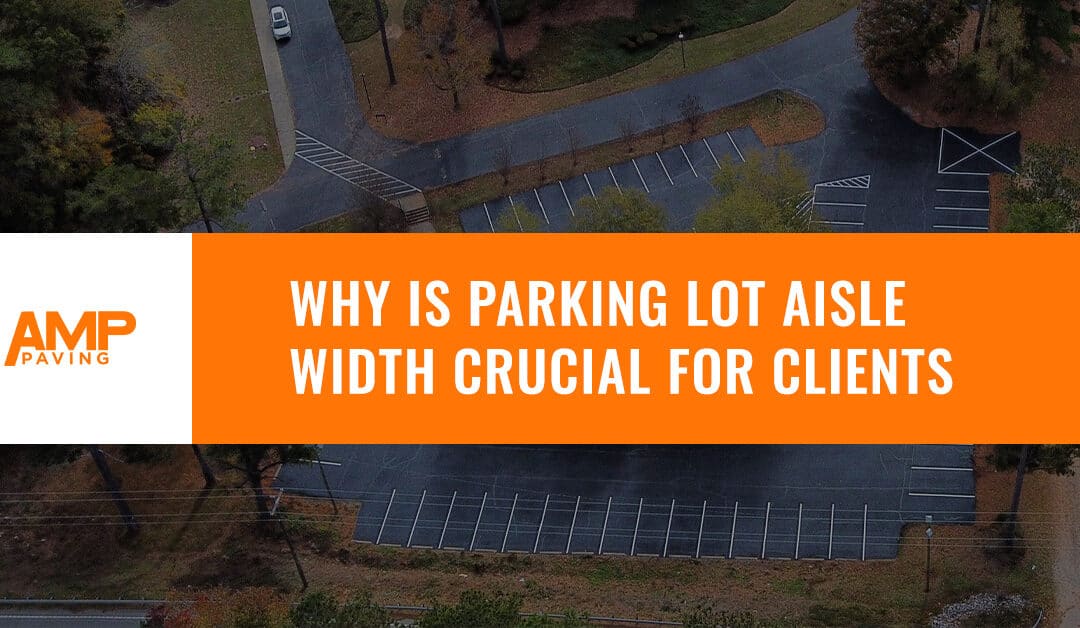As a leading commercial parking lot installation company, we understand the critical role of parking lot aisle width in ensuring a smooth and efficient parking experience. Whether you’re a business owner, property manager, or developer, it’s crucial to recognize the significant impact that well-designed and adequately dimensioned parking lot aisles can have on your customers’ satisfaction, traffic flow, and overall safety.
This article will explore why parking lot aisle width matters to clients and how it can contribute to a positive and hassle-free parking environment.
Parking Spaces Need Ample Aisle Room for Backing and Driving
Parking spaces require ample aisle room to efficiently accommodate both backing and driving maneuvers. Adequate aisle width ensures smooth and safe navigation within a parking lot.
When it comes to backing into a parking space, drivers need sufficient room to maneuver their vehicles easily. Without enough aisle width, backing can become a challenging and potentially hazardous task, leading to an increased risk of collisions and vehicle damage.
Ample aisle room also facilitates convenient driving within the parking lot. Drivers must be able to navigate comfortably through the aisles, especially during peak hours when traffic is heavy. Insufficient aisle width can bring congestion and delays as vehicles struggle to pass each other, resulting in frustration for drivers and potential bottlenecks within the parking lot.
Moreover, wider aisles improve accessibility for drivers with larger vehicles, such as trucks, vans, or SUVs. These vehicles require more space to maneuver and turn, making it essential to have wider aisles to accommodate their size. Parking lots can cater to a diverse range of vehicles by providing sufficient aisle width, ensuring that all customers can access and park their cars conveniently.
Sufficient aisle width reduces the risk of accidents, enhances traffic flow, and promotes accessibility for various vehicles. By prioritizing ample aisle room in parking lot design and maintenance, businesses can enhance the overall parking experience for their clients and customers.
How About Parking Space Dimensions? What is Normal in South Carolina?
When it comes to parking space dimensions in South Carolina, it’s essential to consider the specific regulations and guidelines set forth by the state. While there isn’t a universal standard for parking space dimensions across all jurisdictions, there are generally accepted norms that aim to ensure safe and efficient parking for drivers.
In South Carolina, the typical dimensions for a standard parking space are 9 feet wide by 18 feet long. These dimensions provide enough space for most vehicles to park comfortably and allow easy entry and exit. However, it’s important to note that parking space dimensions can vary depending on the location and specific requirements of a particular property or development.
Do Parking Space Sizes and Shapes Vary Sometimes?
Parking space dimensions vary for compact cars and trucks to accommodate their specific sizes. While the standard dimensions for a parking space are generally suitable for most vehicles, adjustments may be necessary for compact car spaces or larger trucks.
For compact cars, parking stalls can be slightly narrower than the standard dimensions, typically around 8 feet wide instead of 9 feet. This narrower width allows for more efficient use of space while still providing enough room for compact car drivers to enter and exit their vehicles comfortably. The parking area will usually label these spaces to ensure only compact cars pull into those areas.
You may even wish to install a designated on-site location for moped, scooter, bicycle, or motorcycle spaces.
On the other hand, parking spaces for larger trucks may need to be wider and longer than the standard dimensions. For example, a typical truck parking space might be 10 feet wide by 20 feet long. This sizing accommodates the larger size and turning radius of trucks.
Types of Parking Angles
When it comes to parking lot design, one crucial consideration is the layout of parking spaces. There are two common types: angled parking and perpendicular parking.
Angled Parking Areas
Angle parking involves parking spaces positioned at an angle, typically 45 degrees or 60 degrees, to the driving lane. This design allows for easier maneuvering and better visibility when entering and exiting parking spaces. It also provides more space for vehicles to back out safely.
Perpendicular Parking Areas
On the other hand, perpendicular parking features parking spaces arranged parallel to each other and perpendicular to the driving lane. This design is frequently part of parking garages or areas with limited space. While perpendicular parking may provide more parking spaces in a given area, it can be more challenging for drivers to navigate and requires careful attention when maneuvering into and out of slots.
The choice between angled and perpendicular parking depends on several factors, including the:
- Available space
- Traffic flow
- The specific needs of the parking lot users.
The goal is to create a layout that maximizes parking capacity while ensuring drivers’ ease of use and safety.
Other Factors When Striping Your Spaces
In addition to the dimensions and layout of parking spaces, it’s essential to consider other factors such as clearances, signage, and accessibility requirements to create a well-designed and functional parking lot.
By carefully considering these factors, parking lot designers can create a space that accommodates various vehicle sizes, promotes efficient traffic flow, and enhances the overall parking experience for all users.
Property owners, developers, and parking lot designers in South Carolina must adhere to these established parking space dimensions to ensure compliance with local regulations. This adherence allows a positive parking experience for all of their customers.
By following these guidelines, businesses can promote efficient traffic flow and minimize the risk of accidents.
Do Accessible Parking Spaces Need More Parking and Aisle Room?
South Carolina also enforces guidelines for creating a parking area for accessible parking spaces to accommodate individuals with disabilities.
According to the Americans with Disabilities Act (ADA), accessible parking spaces in South Carolina must be at least 8 feet wide by 18 feet long, with an adjacent 5-foot wide access aisle to accommodate wheelchair ramps.
These dimensions ensure that individuals with disabilities can safely and conveniently access their vehicles.
Our Experienced Asphalt Contractors Can Help
Our experienced asphalt contractors at AMP Paving have a proven track record of successfully completing various commercial road and parking projects across South Carolina. With our expertise in the industry, we consistently deliver high-quality results that meet our clients’ unique needs and specifications.
In addition to our commercial projects, we also specialize in residential driveway installations, ensuring durable and attractive surfaces for homeowners. Our services go beyond just paving. We are well-versed in striping to provide clear and organized parking lots, and we ensure accessibility compliance in all our projects.
Moreover, our team is familiar with South Carolina municipal codes, ensuring that our work aligns with local regulations. We also offer asphalt repair and sealcoating services to extend the lifespan of existing surfaces, saving our clients time and money in the long run.
At AMP Paving, we pride ourselves on our commitment to excellence, customer satisfaction, and delivering exceptional results that exceed expectations.

